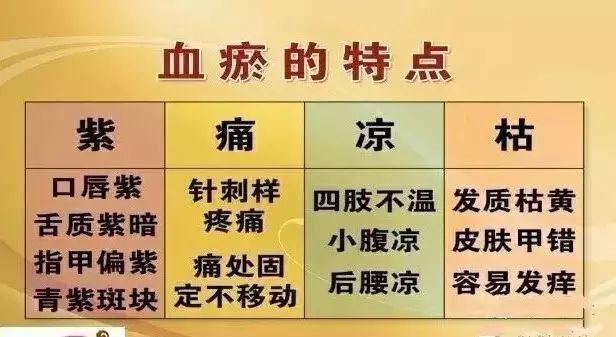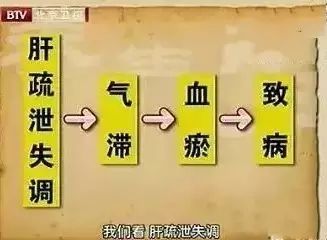
Moxibustion can truly elevate white blood cell counts; where there is moxa, there is no cancer!
Just as rivers can become blocked by silt or garbage, preventing normal flow, blood can also stagnate. Generally speaking, any blood that leaves the meridians and cannot disperse in time, or blood flow that is obstructed and accumulates in the meridians or organs, is referred to as blood stasis (xue yu). Blood stasis is an invisible killer of human health and can be seen in many diseases.
So, how can one determine if they have blood stasis? You can observe the following aspects.
1. Pain
“Where there is pain, there is obstruction; where there is no pain, there is no obstruction.” Internal blood stasis often manifests as pain in specific areas of the body, with fixed, stabbing pain that is more pronounced at night, and tenderness upon pressure.
2. Masses
Blood stasis can lead to palpable, hard masses within the abdominal cavity. Recurrent bleeding caused by blood stasis is often intermittent and persistent.
3. Cyanosis
Blood stasis can cause superficial signs such as purplish discoloration, dark lips, tongue, and nails; one may also observe a dark complexion, rough skin without luster, and skin peeling or itching.

Common causes of blood stasis include:
Qi stagnation → blood flow obstruction → blood stasis (qi zhi xue yu);
Qi deficiency → inability to move blood → blood stasis (qi xu xue yu);
Blood cold → cold leads to stagnation;
Blood heat → blood is scorched;
Phlegm-damp obstruction → meridians are blocked → blood stasis.
It is well known that moxibustion, in addition to warming the meridians and dispelling cold, has another important function—activating blood and resolving stasis.
The “Lingshu: On Needling” states: “When blood in the vessels coagulates and stagnates, it cannot be removed without fire treatment.“
Qi is the commander of blood; blood follows qi. When qi is warmed, it flows; when qi flows, blood also flows. Moxibustion can regulate the qi mechanism, harmonizing the nutritive and defensive qi, thus allowing stasis to disperse.
There are five commonly used acupuncture points for activating blood and resolving stasis: San Yin Jiao (Spleen 6), Xue Hai (Spleen 10), He Gu (Large Intestine 4), Qu Chi (Large Intestine 11), Zu San Li (Stomach 36). These points are well-known and frequently used in moxibustion, connecting from the hands to the feet, along the outer sides of the lower limbs, closely related to the internal organs and reflecting the functions of the body’s blood vessels and nerves.
Therefore, regularly performing moxibustion on these points can unblock the twelve meridians, mobilize the joints of the limbs, promote overall blood circulation, activate blood, resolve stasis, and effectively prevent and treat various diseases, including arthritis.
Pattern Differentiation:Qi stagnation and blood stasis: soothe the liver, relieve depression, activate blood and resolve stasis, adding points such as Gan Shu (Bladder 18), Qi Men (Liver 14), Tai Chong (Liver 3);

Qi deficiency and blood stasis: add Guan Yuan (Conception Vessel 4), Qi Hai (Conception Vessel 6), Zhong Wan (Stomach 12), Dan Zhong (Conception Vessel 17);Blood cold and blood stasis: Xin Shu (Bladder 15), Gan Shu (Bladder 18), Pi Shu (Bladder 20), Shen Shu (Bladder 23), Guan Yuan (Conception Vessel 4), Yin Ling Quan (Spleen 9);Blood heat and blood stasis: points such as Tai Chong (Liver 3), Zhong Du (Spleen 6), Ge Shu (Bladder 17);Phlegm-damp obstruction: points such as Yin Ling Quan (Spleen 9), Zhong Wan (Stomach 12), Tian Shu (Stomach 25), Shui Fen (Conception Vessel 9) with modifications;Trauma: add moxibustion on Da Zhu (Bladder 11), Yang Ling Quan (Gallbladder 34) and other points.
Daily Moxibustion:
1. Understand your constitution and select appropriate points for gentle moxibustion with moxa sticks, about 15 minutes per point. If using a moxibustion can, extend the time to 20-30 minutes.
2. Ah Shi points are also key treatment areas. Moxibustion should be applied directly to areas of soreness, numbness, or pain, as this yields better results, with the same duration as above.
Notes Before and After Moxibustion:
-
Avoid moxibustion when intoxicated, fasting, overly hungry, overly full, extremely shocked, extremely angry, sweating profusely, or extremely fatigued.
-
Pregnant women and those with a pulse over 90 should be cautious with moxibustion; it should be avoided during menstruation; and should be performed under the guidance of a physician in cases of skin ulcers.
-
After moxibustion, keep warm and avoid cold; do not drink cold water or come into contact with cold water. Wait at least half an hour after moxibustion before taking a hot bath.
-
During moxibustion treatment, avoid spicy and stimulating foods; maintain a light diet.
-
If you feel angry during moxibustion, it can obstruct the meridians and worsen blood stasis.
-
It is best to drink 200-250 ml of warm water before moxibustion and 200-250 ml of warm water after moxibustion, or even a bit more.
-
During and after moxibustion, as the pores are open, avoid wind, especially air conditioning and fans.
-
If blisters form on the skin, small blisters can be absorbed naturally, while larger blisters can be punctured and disinfected. It is best to wait until the area has scabbed over before performing moxibustion again. Gentle moxibustion can be applied to the sore area, but the temperature should not be too high to keep the wound dry and promote early scab formation and shedding.



